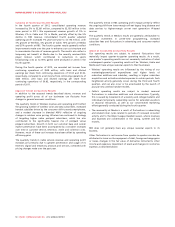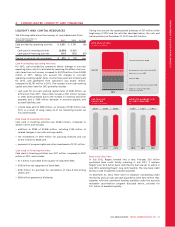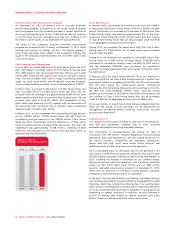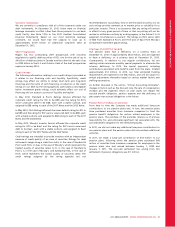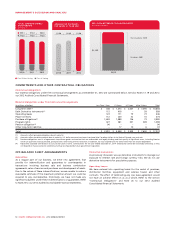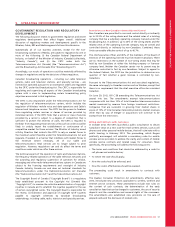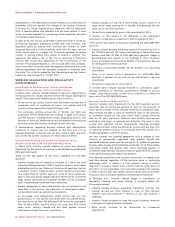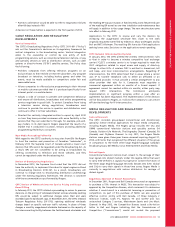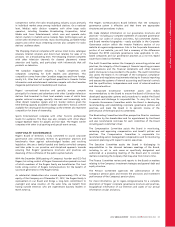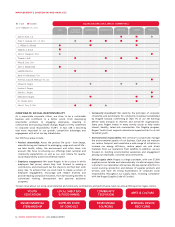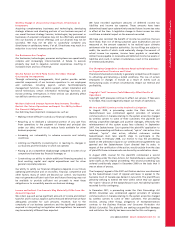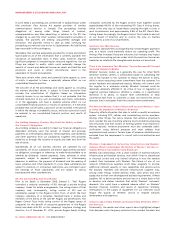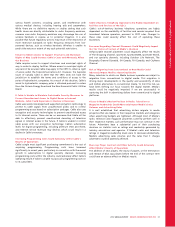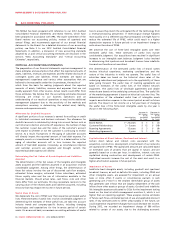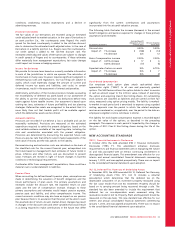Rogers 2012 Annual Report Download - page 64
Download and view the complete annual report
Please find page 64 of the 2012 Rogers annual report below. You can navigate through the pages in the report by either clicking on the pages listed below, or by using the keyword search tool below to find specific information within the annual report.MANAGEMENT’S DISCUSSION AND ANALYSIS
acquisition. In July 2012, the CRTC approved the transfer of the five
television licences held by MLSE in which Rogers subsequently
completed a 37.5% investment.
In the first quarter of 2012, Rogers Media announced an agreement
to purchase the Saskatchewan Communications Network, an over-the-
air broadcast station. In June 2012, the CRTC approved the
acquisition.
In August 2012, Rogers announced that it had entered into an
agreement to purchase 100% of the outstanding shares of Score
Media Inc. for $167 million. As part of this transaction, Rogers also
received a 10% interest in Score Media’s digital media assets, which
has been spun out as a separate entity called Score Digital. Score
Media Inc. includes theScore Television Network, a national specialty
TV service providing sports news, information, highlights and live
event programming across Canada. This transaction is subject to
regulatory approval, anticipated in the first half of 2013, following
which Rogers will wholly own and control theScore Television
Network and its related television assets.
Further in regard to theScore Media Inc. transaction in October of
2012, the $167 million purchase price was paid and the shares of
Score Media were transferred to an interim CRTC-approved trust that
is responsible for the independent management of the business in the
normal course of operations until CRTC approval is obtained. The
ultimate control over theScore Media business will not transfer to
Rogers until such approval is obtained. In addition, Rogers holds
approximately 11.8% of the outstanding shares of Score Digital,
which includes 10% that will be issued in connection with this
transaction and approximately 1.8% of the shares of Score Digital
received by Rogers as partial payment for our shareholdings in Score
Media prior to the acquisition.
COMPETITION IN OUR BUSINESSES
We currently face significant competition in each of our Wireless,
Cable, RBS and Media businesses from entities that provide similar
services. Each of our segments also faces competition from entities
that use alternative communications and transmission technologies
and may face competition from other technologies being developed
or to be developed in the future. This section contains a discussion of
the specific competition facing each of our Wireless, Cable, RBS and
Media businesses.
Wireless Competition
With approximately 27 million subscribers, Canada’s wireless industry
is highly competitive. Competition for wireless subscribers is based on
price, quality of service, scope of services, network coverage,
sophistication of wireless technology, breadth of distribution,
selection of devices, branding and marketing. Wireless also competes
with its rivals for dealers and retail distribution outlets.
In the wireless voice and data market, Wireless competes nationally
with Bell and TELUS, as well as newer entrants, various regional
players, resellers, and other emerging providers that use alternative
wireless technologies, such as WiFi “hotspots”.
As previously noted, parity of Wireless networks and handset devices
has dramatically transformed the competitive landscape. This
competition is expected to continue and even intensify. Consolidation
among new entrants or with incumbent carriers could provide greater
competition to Wireless on a regional or national basis. As previously
discussed, in 2013 and 2014, auctions of 700 MHz and 2500-2690 MHz
spectrum respectively, are expected to be held. Rogers will not be
allowed to participate in the auction of the 2,500-2,690 MHz
spectrum, because the company already holds more than the
maximum 40 MHz of spectrum limit to bid in this auction. The
outcomes of both of these auctions may serve to increase competition
at Wireless.
Rogers was the first carrier to launch LTE in Canada in 2011. In 2011
Bell Canada launched LTE, and in 2012 both TELUS and MTS launched
LTE networks. The Bell Canada, TELUS, and MTS launches of LTE
enable these companies to provide a wider selection of wireless
devices and to compete for customers who desire the increased
capacity and speed that LTE provides, and this is expected to grow
over time as LTE expands around the world.
Cable Competition
Canadian cable television systems face competition from several
alternative Canadian multi-channel BDUs including Bell TV (previously
Bell ExpressVu), Shaw Direct (previously Star Choice) satellite TV
services and telephone company IPTV services, as well as from the
direct reception by antenna of over-the-air local and regional
broadcast television signals. There is also competition from the illegal
reception of U.S. direct broadcast satellite services. In addition, the
availability of television shows and movies streaming over the
Internet through providers such as Netflix has become a direct
competitor to Canadian cable television systems.
Cable’s Internet access services compete with a number of other ISPs
offering residential and commercial dial-up and high-speed Internet
access services. Rogers Hi-Speed Internet services, where available,
compete directly with Bell’s DSL Internet service in the Internet
market in Ontario, with the DSL Internet services of Bell Aliant in New
Brunswick and Newfoundland and various resellers using wholesale
telco DSL and cable Third Party Internet Access services in local
markets.
Cable’s Home Phone services compete with Bell’s wireline phone
service in Ontario and with Bell Aliant’s wireline phone service in New
Brunswick and Newfoundland and Labrador. In addition, Home
Phone service competes with ILEC local loop resellers (such as Primus)
as well as VoIP service providers (such as Vonage and Primus) riding
over the services of ISPs.
Internet delivery is becoming a direct threat to voice and video service
delivery. Younger generations increasingly use the Internet as a
substitute for traditional wireline telephone and television services.
The use of mobile phones among younger generations has resulted in
some abandonment of wireline telephone service. The number of
wireless-only households is increasing, although the large majority of
homes today continue to use wireline telephone service. In addition,
wireless Internet service is increasing in popularity, although is
generally more expensive and not as fast as wired broadband.
RBS Competition
The Canadian market for enterprise network and communications
services features a wide variety of players, with competitors often
focusing on individual geographic markets where their respective
network assets are most extensive. Although each market presents its
own challenges, with competitors investing in maintaining market
share in these target areas, there are relatively few national
providers.
In the wireline voice and data market, RBS competes with facilities
and non-facilities-based telecommunications service providers. In
markets where Rogers owns fibre and cable infrastructure, direct
competition is with incumbent fibre-based providers. In Ontario, RBS
products and services compete with Bell, Cogeco Data Services and
Allstream. In Quebec, competition is predominantly with Bell and
Videotron, and with Bell Alliant and Eastlink in Atlantic Canada.
Media Competition
Rogers’ radio stations compete with the other stations in their
respective markets as well as with other media, such as newspapers,
magazines, television, outdoor advertising and digital properties.
60 ROGERS COMMUNICATIONS INC. 2012 ANNUAL REPORT


